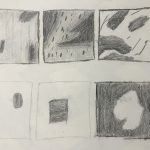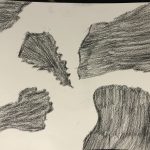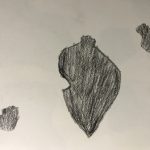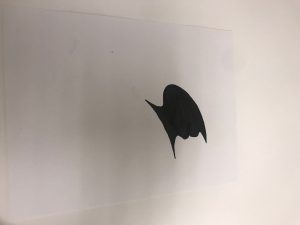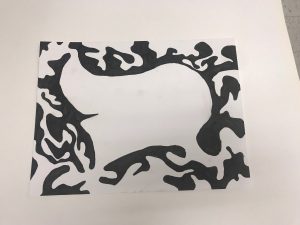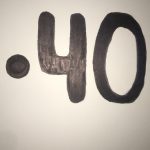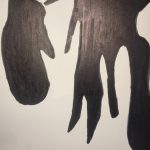My thoughts on this project are that it was fun, I enjoyed and like the final look of what I’ve done for the project, yes it took different steps and a longer time period but it was a fun process. What I’ve learned would be the difference between ambiguous and stable drawing along with the elements it needs to be considered one or the other or any details that can be added to it. To the criticism I recieved on the project, making the lines a bit thicker would be best in changing of the artwork and something I would keep in mind for the next project and consider its effect it can have on what I do in future projects.
In this project, I have learned the difference between a stable figure relationship and an ambiguous figure relationship.
A stable figure relationship is when you can clearly see the object from the background
An ambiguous figure relationship is when you can’t see the object from the background
I try to create a connection between my ambiguous and my stable drawing. When I was presenting my work, I learned that my first stable wasn’t good enough, so I started over and make a new one using some of my ambiguous objects.
Urban Artifacts: phase 3
Thursday COMD Reminder
Check the COMD class site to see what is due and what materials are needed for class on Thursday/tomorrow.
See you soon!
Matriarch
Matriarch
Urban Artifacts: Phase 4
After the criticism i received from class, i needed to make these two pictures relate to each other. By doing that i took the circle from the stable figure and added it to the ambiguous figure. With the circle, the ambiguous figure looks like something spilled and covered up the 40. From what i learn from the critics, for the upcoming projects i will use figures that are able to relate to each other.
Urban Artifacts: Phase 3
Here we have one stable and one ambiguous. The stable one is a .40 that I found outside of city tech by the bicycles. It is stable because you can clearly see the number from the background. The second picture is a stain that is near the Nathans hot dog stand a few blocks down from city tech by the train station. It is ambiguous because the background and figure are equal and if you were to turn it and look at it from a different side it would show more than one thing. I chose these two because it took place in near the school. Each of these drawings were taken from phase 2.
Ways of Seeing (Role 1)
In general, the video ‘John Berger / Ways of Seeing’ gives us different examples on how our views on anything, or on paintings in this case, are altered with the main cause being the use of the camera. One of the points that interested me more was starting at minute 19:32 where John Berger states “The meaning of an image can be changed according to what you see beside it or what comes after it” and it shows how easily influenced one is when a different context is given to someone such as with the Goya painting the video uses as an example by first using a clip with women dancing and the upbeat music that once the image appears it feels like it has less of a serious meaning. However, once they show the next clip with no audio then the image it gives a deeper meaning and relating it to the clip, even more, based on the upsetting feeling the clip would give. Anything can alter the meaning of a painting it can move it away from what it means or bring it closer. To other maybe it won’t it could be due to prior knowledge of the painting that the meaning of the painting can just stick and stay the same even if there is a painting with a completely different meaning or maybe it can still influence in giving a different view or bring out a different aspect of the painting giving another alteration to a painting and our way of seeing it.
Discussing “Ways of Seeing” with our different roles
Congratulations to you , our first group of Role 1 posters, for posting about Part 1 of “Ways of Seeing”! Now everyone who signed up to respond can do so. If you need to remember what this whole Roles thing is or how this assignment will work, check out this previous post I made describing what you need to do and when.
Here are the Role 1 posts: from @vhenny space mind, from @bribrianna Brianna M, from @airy Air (E.N.). @rcortes, you were also going to post a Role 1 post–there’s still time today or even early tomorrow morning–so long as the next group has time to read, process, and add their work.
Role 2 folks: that’s @garence, @sruan, and @ezraab. Get ready to post something by Wednesday (again, early Thursday morning won’t destroy us in this first round, especially with the holiday, but we’ll get on a stricter schedule as this becomes more comfortable to each of us). Read the above posts and choose one to respond to. If someone has already responded, please move on to another until they’re all responded to once before doubling up (this is more a concern for Role 3 this time, since everyone wanted that).
Role 3 folks: that’s everyone else (unless you decide to add to Role 2 just to balance things out). You’ll add your responses by Thursday (or early on Friday, again, just this time). Remember to choose a post that doesn’t already have a Role 3 response until all have one, then make sure it doesn’t already have 2. We want to keep things even, so everyone gets to enjoy the conversation!
After this round, we’ll move on to Part 2 of “Ways of Seeing,” then Part 3. We’ll check in before Part 4 to see if we need to adjust. Your role for each shifts down one (Role 1 becomes Role 2, Role 2 becomes Role 3, and Role 3 becomes Role 1).
This might sound complicated, but it will be exciting to have more of our work read and responded to than all of us talking at once with no one listening!
Ways of Seeing Part 1
In this video, John Berger made an interesting statement where he says, “perspective makes the eye the centre of the visible world. ” He talks about how the camera chnaged not only what we see, but how we see it . With painting for example, the camera can reproduce it, making available for everyone to see worldwide. When it comes to art, nearly everything we learn or read about, it encourages an attitude and expectation. That “important” paintings are protected not because of it’s meaning or what it shows. Mostly because of it’s market value. “The most important thing about paintings themselves is that their image are silent, still” quote by john berger. He also noted that music and rhythm changed the significance of a picture. That images are more like words than holy relic.

